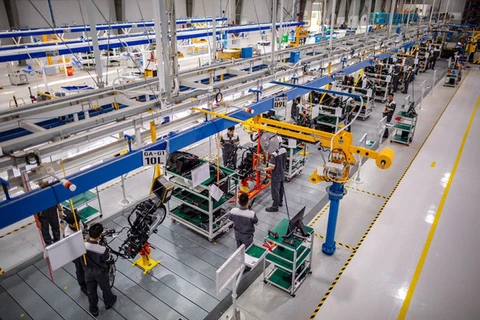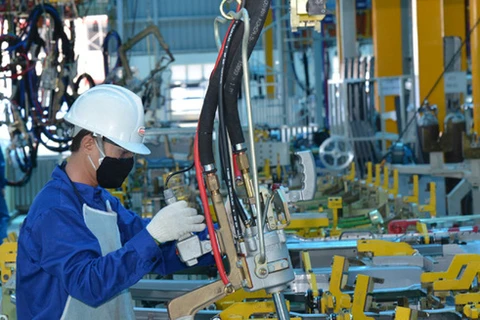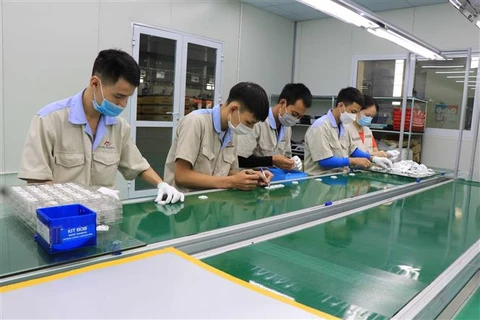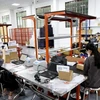Hanoi (VNA) – Vietnamese firms operating in supporting industries have been developing in recent years, as products have partly met demand in the domestic market and for export.
Some businesses have applied advanced management tools in production and met international standards, thus becoming suppliers of multinational companies.
Statistics of the Industry Agency under the Ministry of Industry and Trade (MoIT) show that, Vietnam now has 2,000 firms producing components and spare parts. Of them, only 300 can join in the supply network of transnational corporations.
Supporting industries firms account for nearly 4.5 percent of all manufacturing and processing businesses and have created more than 600,000 jobs, or 8 percent of the workforce in the manufacturing and processing sector.
Some Vietnamese firms with good capacity have met domestic demand and are able to ship their products abroad.
However, the overall problem of the sector is the small scale and modest production capacity of most companies. Most of them lack resources and technologies to improve their productivity, along with a shortage of skilled labourers.
Most products of domestic enterprises are simple components and parts, with medium or low technological content and low product value.
A report in the industry and trade sector compiled by the Government pointed out limits in self-sufficiency in the supply of supporting industries products, and the low localistion rate, particularly in garment – textiles, footwear, electronics, informatics and telecommunication.
As Vietnam heavily relies on material imports, when COVID-19 emerges in supply countries, the industries face numerous hardships in ensuring input and have to wait until the pandemic subsides in such markets.
As Vietnam posted a trade deficit in input materials in recent years, added value of domestic industrial products stays low.
The reasons include limited resources for and slow rate of policy implementation. Some preferential policies for supporting industries projects have yet to create a momentum for domestic firms which enjoy fewer incentives than foreign invested ones.
The Government issued a resolution last year on measures to further propel supporting industries, setting out development goals for the next decade.
Accordingly, Vietnamese enterprises are to be able to produce highly-competitive support products, meeting 45 percent of essential needs for domestic production and consumption and accounting for about 11 percent of industrial production value by 2025.
The country should have about 1,000 enterprises capable of directly supplying for assembly enterprises and multinational corporations operating in Vietnam, with domestic enterprises to account for about 30 percent by 2025.
By 2030, locally-made support products should meet 70 percent of domestic demand and account for about 14 percent of industrial production value. Some 2,000 companies are to be capable of supplying directly to assemblers and multinational corporations by 2030.
To implement the resolution, the MoIT has identified that the development of supporting industries will follow the direction of selecting fields that require investment suitable to different periods. It also chose a number of key industries such as auto, electronics, garment and textile, and leather and footwear.
The ministry has approved a programme for supporting industries development in 2021 with a budget of nearly 240 billion VND (10.6 million USD).
In a report submitted to the National Assembly Standing Committee and legislators early this year, the Government cited statistics showing that companies in supporting industries’ net revenue now tops 900 trillion VND, or about 11 percent of the sector’s total.
Some Vietnamese enterprises boast relatively good capacity in producing moulds, bicycle and motorbike components, electrical cables, plastic and rubber components, and tyres, meeting domestic demand and the requirements of foreign importers.
The report noted that supporting industries play a decisive role in restructuring the economy, improving workplace productivity and skills, and promoting the competitiveness and quality of Vietnamese goods and the economy./.
Some businesses have applied advanced management tools in production and met international standards, thus becoming suppliers of multinational companies.
Statistics of the Industry Agency under the Ministry of Industry and Trade (MoIT) show that, Vietnam now has 2,000 firms producing components and spare parts. Of them, only 300 can join in the supply network of transnational corporations.
Supporting industries firms account for nearly 4.5 percent of all manufacturing and processing businesses and have created more than 600,000 jobs, or 8 percent of the workforce in the manufacturing and processing sector.
Some Vietnamese firms with good capacity have met domestic demand and are able to ship their products abroad.
However, the overall problem of the sector is the small scale and modest production capacity of most companies. Most of them lack resources and technologies to improve their productivity, along with a shortage of skilled labourers.
Most products of domestic enterprises are simple components and parts, with medium or low technological content and low product value.
A report in the industry and trade sector compiled by the Government pointed out limits in self-sufficiency in the supply of supporting industries products, and the low localistion rate, particularly in garment – textiles, footwear, electronics, informatics and telecommunication.
As Vietnam heavily relies on material imports, when COVID-19 emerges in supply countries, the industries face numerous hardships in ensuring input and have to wait until the pandemic subsides in such markets.
As Vietnam posted a trade deficit in input materials in recent years, added value of domestic industrial products stays low.
The reasons include limited resources for and slow rate of policy implementation. Some preferential policies for supporting industries projects have yet to create a momentum for domestic firms which enjoy fewer incentives than foreign invested ones.
The Government issued a resolution last year on measures to further propel supporting industries, setting out development goals for the next decade.
Accordingly, Vietnamese enterprises are to be able to produce highly-competitive support products, meeting 45 percent of essential needs for domestic production and consumption and accounting for about 11 percent of industrial production value by 2025.
The country should have about 1,000 enterprises capable of directly supplying for assembly enterprises and multinational corporations operating in Vietnam, with domestic enterprises to account for about 30 percent by 2025.
By 2030, locally-made support products should meet 70 percent of domestic demand and account for about 14 percent of industrial production value. Some 2,000 companies are to be capable of supplying directly to assemblers and multinational corporations by 2030.
To implement the resolution, the MoIT has identified that the development of supporting industries will follow the direction of selecting fields that require investment suitable to different periods. It also chose a number of key industries such as auto, electronics, garment and textile, and leather and footwear.
The ministry has approved a programme for supporting industries development in 2021 with a budget of nearly 240 billion VND (10.6 million USD).
In a report submitted to the National Assembly Standing Committee and legislators early this year, the Government cited statistics showing that companies in supporting industries’ net revenue now tops 900 trillion VND, or about 11 percent of the sector’s total.
Some Vietnamese enterprises boast relatively good capacity in producing moulds, bicycle and motorbike components, electrical cables, plastic and rubber components, and tyres, meeting domestic demand and the requirements of foreign importers.
The report noted that supporting industries play a decisive role in restructuring the economy, improving workplace productivity and skills, and promoting the competitiveness and quality of Vietnamese goods and the economy./.
VNA

























